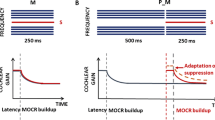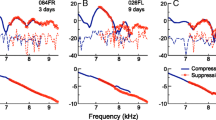Summary
Correlations were made between the detection thresholds of evoked otoacoustic emissions (EOAEs), subjective click thresholds, and mean audiometric thresholds in 240 normal and hearing-impaired ears. EOAEs have never been observed when subjective click thresholds or mean audiometric thresholds were equal to or greater than 35 dB HL. EOAEs were always found when click thresholds were equal to or lower than 15dB HL and when mean audiometric thresholds were equal to or lower than 22dB HL. The incidence of EOAEs decreased and EOAE thresholds increased with increasing click or mean audiometric thresholds.
Similar content being viewed by others
References
Bonfils P, Uziel A, Pujol R (1987) Les oto-émissions acoustiques. I. Les oto-émissions provoquées: une nouvelle technique d'exploration de la cochlée. Ann Otolaryngol Chir Cervicofac 104:353–360
Davis H (1983) An active process in cochlear mechanics. Hear Res 9:79–90
Elberling C, Parbo J, Johnsen NJ, Bagi P (1985) Evoked acoustic emissions: clinical application. Acta Otolaryngol (Stockh) [Suppl] 421:77–85
Grandori F (1983) Evoked oto-acoustic emissions stimulus-response relationship. Rev Laryngol Otol Rhinol (Bord) 10:153–155
Grandori F (1985) Non linear phenomena in click- and tone-burst-evoked oto-acoustic emissions. Audiology 24:71–80
Horst JW, Wit HP, Ristma RJ (1983) Psychophysiological aspects of cochlear acoustic emissions. In: Klinke R, Hartman R (eds) Hearing — physiological bases and psychophysics. Springer, Berlin Heidelberg New York, pp 89–96
Johnsen NJ, Elberling C (1982) Evoked acoustic emissions from the human ear. II. Normative data in young adults and influence of posture. Scand Audiol 11:60–77
Kemp DT (1978) Stimulated acoustic emissions from the human auditory system. J Acoust Soc Am 64:1386–1391
Kemp DT (1986) Acoustic emission cochleography. Practical aspects. Scand Audiol [Suppl] 25:71–95
Probst R, Coats AC, Martin GK, Lonsbury-Martin BL (1986) Spontaneous click- and tone-burst-evoked otoacoustic emissions from normal ears. Hear Res 21:261–275
Probst R, Lonsbury-Martin BL, Martin GK, Coats AC (1987) Otoacoustic emissions in ears with hearing loss. Am J Otolaryngol 8:73–81
Rutten WLC (1980) Evoked acoustic emissions from within normal and abnormal ears: comparison with audiometric and electrocochleographic findings. Hear Res 2:263–271
Wit HP, Langevoort JC, Ristma RJ (1981) Frequency spectra of cochlear acoustic emissions. J Acoust Soc Am 70:437–445
Zwicker E (1983) Delayed evoked oto-acoustic emissions and their suppression by Gaussian-shaped pressure impulses. Hear Res 11:359–371
Author information
Authors and Affiliations
Rights and permissions
About this article
Cite this article
Bonfils, P., Piron, JP., Uziel, A. et al. A correlative study of evoked otoacoustic emission properties and audiometric thresholds. Arch Otorhinolaryngol 245, 53–56 (1988). https://doi.org/10.1007/BF00463550
Received:
Accepted:
Issue Date:
DOI: https://doi.org/10.1007/BF00463550




